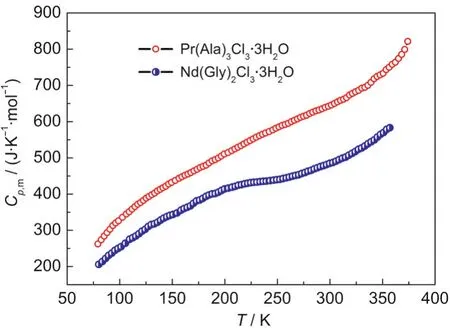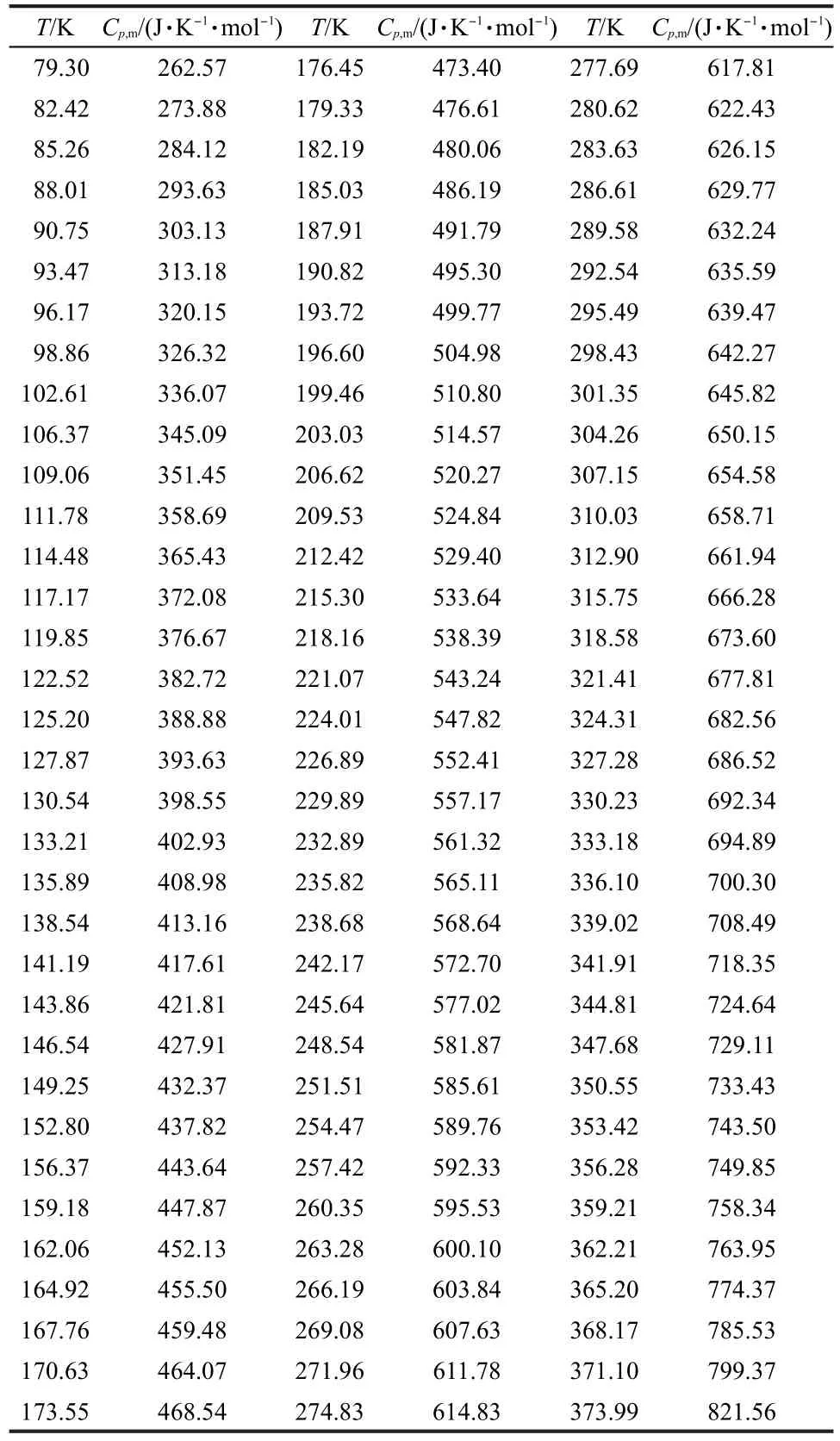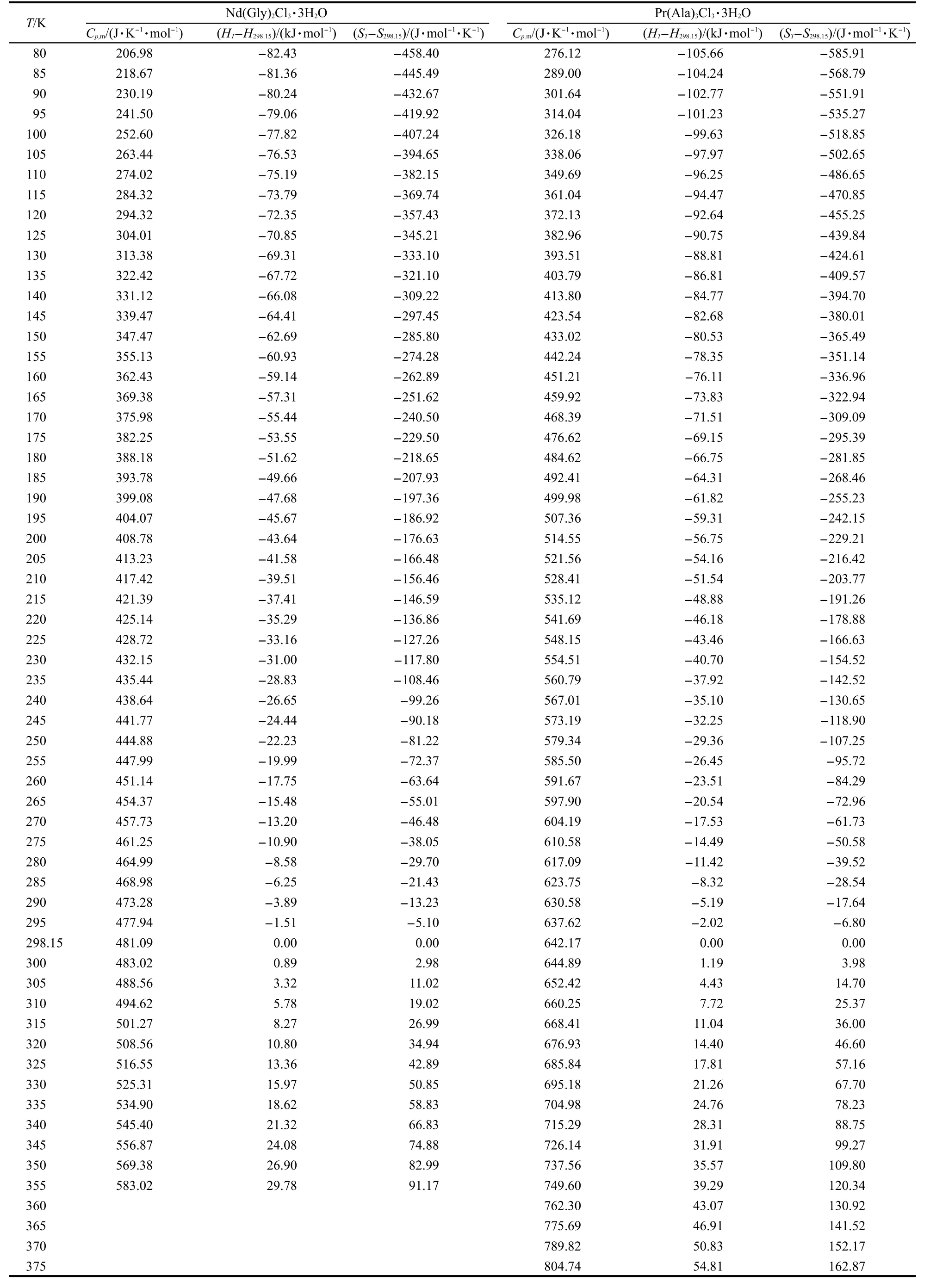Thermodynamic Properties of Nd(Gly)2Cl3·3H2O and Pr(Ala)3Cl3·3H2O
LIU Bei-Ping TAN Zhi-Cheng
(1College of Chemistry and Chemical Engineering,Hunan University of Arts and Science,Changde 415000,Hunan Province,P.R.China; 2Thermochemistry Laboratory,Dalian Institute of Chemical Physics,Chinese Academy of Sciences,Dalian 116023,Liaoning Province,P.R.China)
1 lntroduction
Since the pioneering work of Anghileri,1rare-earth complexes with amino acids have received a great deal of attention due to their potential use in the wool dyeing industry as dyeing accelerant and in agriculture as additive because of their physiological and biochemical effects.2,3So far,nearly 200 kinds of solid complexes of rare-earth compounds with L-amino acids have been reported,many research activities have focused on the syntheses of these complexes and their relevant applications,whereas,few thermodynamic properties of rare-earth compounds were reported.It is necessary to obtain basic thermodynamic properties as the basis for theoretical research and industrial design when they are synthesized and developed industrially.4,5However,until now,the basic thermodynamic properties of rare-earth complexes with amino acids were reported in literature rarely.6
As a continuation of the research project of thermochemistry study on complex of rare-earth compounds with amino acids,in the present work,the low-temperature heat capacities of two kinds of rare-earth element solid complexes,Nd(Gly)2Cl3·3H2O(where Gly=glycine)and Pr(Ala)3Cl3·3H2O(where Ala=alanine)have been measured by a high-precision automatic adiabatic calorimeter in the temperature ranges from 80 to 357 K for Nd(Gly)2Cl3·3H2O,and from 80 to 374 K for Pr(Ala)3Cl3·3H2O.The thermodynamic functions,(HT-H298.15)and (STS298.15),of the two compounds were calculated on the basis of experimental heat capacity data.Possible mechanisms of thermal decompositions for the pair of rare-earth complexes were suggested according to the thermogravimetric(TG)analysis.The standard molar enthalpies of formation of the two compounds were calculated through a designed Hess thermochemical cycle and a solution-reaction isoperibol calorimeter.
2 Experimental
2.1 Sample synthesis and characterization
According to the literature,7,8the rare-earth oxide(RE2O3,RE=Nd,Pr,>99.99%),hydrochloric acid and Aa[Aa=Gly(RE=Nd),Ala(RE=Pr)]were used to prepare the two samples,Nd(Gly)2Cl3·3H2O and Pr(Ala)3Cl3·3H2O.Firstly,the RE2O3was dissolved in hydrochloric acid to prepare the aqueous solution of the rare-earth chloride,then the aqueous solution was mixed with glycine(>99.5%)at the mole ratios of 1:2 for Nd(Gly)2Cl3·3H2O and with alanine(>99.5%)1:3 for Pr(Ala)3Cl3·3H2O at about pH=3,which was adjusted by adding a suitable amount of NaOH.The mixed solution was concentrated by evaporation,cooled and filtered.The filtrate was placed into a desiccator over P2O5until the product was crystallized.The crystal was filtered out and washed with anhydrous alcohol for three times.Finally,the crystal was desiccated in a dryer until its mass became constant.
The contents of Gly(Ala),Cl,and RE were determined respectively by formaldehyde alkalimetric titration,ethylene diamine tetraaceticacid(EDTA)titration,and Mohr method.The actual amounts of C,H,N were determined by the elemental analyzer(PE-2400II).The formula of the as-prepared rareearth complexes were determined to be Nd(Gly)2Cl3·3H2O and Pr(Ala)3Cl3·3H2O,respectively and the results are given in Table 1,and the purity obtained from the EDTA titration under the same conditions was found to be 99.46%for Nd(Gly)2Cl3·3H2O and 99.19%for Pr(Ala)3Cl3·3H2O,which were high enough to meet the requirements of the present calorimetric study.

Table 1 Mass fractions(%)of chemical elements of the complexes
2.2 Adiabatic calorimeter
A high-precision automatic adiabatic calorimeter was applied to measure the heat capacities over the temperature range from 78 to 378 K.The calorimeter was established in Thermochemistry Laboratory of Dalian Institute of Chemical Physics,Chinese Academy of Sciences.The principle and structure of the adiabatic calorimeter were described in detail elsewhere.9-11The calorimeter consists of a sample cell,inner and outer adiabatic shields,a platinum resistance thermometer,an electric heater,two sets of differential thermocouples,and a high vacuum can(1×10-3Pa).Liquid nitrogen was used as the cooling medium.The principle of the calorimeter is based on the Nernst stepwise heating method.The heat capacity measurements were conducted by the standard procedure of intermittently heating the sample and alternately measuring the temperature.The heating rate and the temperature increment for each experimental point were generally controlled to 0.1-0.4 K·min-1and 1-4 K,respectively.The heating duration for one point was 10 min,and the temperature drift rate of the sample cell in an equilibrium period was kept within 10-3-10-4K·min-1during the acquisition of heat capacity data.The precision of measuring sample temperature was±0.001 K.
Calibration of the adiabatic calorimeter was performed with reference standard material,α-Al2O3(SRM720)(1.6382 g,0.016 mol).Deviations of the measured heat capacity ofα-Al2O3from the recommended values reported by Archer of NIST12were within±0.3%in the temperature range from 78 to 400 K.
2.3 Thermal analysis
A thermogravimetric analyzer(Model TGA/SDTA851e,METTLER TOLEDO,Switzerland)was used for TG measurements of the solid complexes under high purity(99.999%)nitrogen atmosphere with a flow rate of 60 mL·min-1.The masses of the samples used for TG analyses were 1.3180 and 1.7220 mg for Nd(Gly)2Cl3·3H2O and Pr(Ala)3Cl3·3H2O,respectively.The heating rate was 10 K·min-1.
2.4 Solution-reaction isoperibol calorimeter
The solution-reaction isoperibol calorimeter(SRC-100)used for this study was constructed in Thermochemistry Laboratory of Wuhan University,China and has been used for measuring enthalpies of solid-liquid,liquid-liquid reactions.13,14The calorimeter mainly consisted of a water thermostat,a pyrex-glass Dewar with volume of 100 mL,a glass sample cell with volume of 2 mL,a heater for calibration and equilibration purposes,a glass-sheathed thermistor probe,an amplifier,a circuit used as an A/D converter,and a personal computer for data acquisition and processing.The Dewar vessel,equipped with a twin-blade stirrer,served as a mixing chamber,was submerged in the water thermostat.The precisions of controlling and measuring the temperature of the calorimeter were±0.001 and±0.0001 K,respectively.The measurements of solution-reaction enthalpy of samples were conducted under atmospheric pressure.
3 Results and discussion
3.1 Heat capacity
The mass of the complex used for heat-capacity measurements was 3.45892 g,which is equivalent to 0.00761 mol for Nd(Gly)2Cl3·3H2O and 3.15478 g which is equivalent to 0.00555 mol for Pr(Ala)3Cl3·3H2O,based on their corresponding molar masses of 454.65 g·mol-1for Nd(Gly)2Cl3·3H2O and 568.38 g·mol-1for Pr(Ala)3Cl3·3H2O.The experimental molar heat capacities,Cp,m,as a function of temperature,T,of the two compounds are plotted in Fig.1.Low-temperature molar heat capacities of the complexes were measured by the adiabatic calorimeter over the temperature range from 80 to 357 K for Nd(Gly)2Cl3·3H2O(Fig.1 and Table 2)and from 80 to 374 K for Pr(Ala)3Cl3·3H2O(Fig.1 and Table 3).
It can be seen from Fig.1 that theCp,m-Tcurves are smooth and continuous,no thermal anomaly occurred in the entire experimental temperature range,which indicates that the structure of the two complexes are stable from 80 to 357 K for Nd(Gly)2Cl3·3H2O and from 80 to 374 K for Pr(Ala)3Cl3·3H2O.

Table 2 Experimental molar heat capacities of Nd(Gly)2Cl3·3H2O(molar mass:M=454.65 g·mol-1)

Fig.1 Experimental molar heat capacities of Nd(Gly)2Cl3·3H2O and Pr(Ala)3Cl3·3H2O as a function of temperature
The polynomial equations to describe the heat capacity as a function of temperature were obtained by the least-squares fitting from the experimental molar heat capacities(Cp,m,in J·K-1·mol-1)and the experimental temperature(T).For solid complex Nd(Gly)2Cl3·3H2O over the temperature range of 80 to 357 K:

Table 3 Experimental molar heat capacities of Pr(Ala)3Cl3·3H2O(molar mass:M=568.38 g·mol-1)

Table 4 Thermodynamic functions of Nd(Gly)2Cl3·3H2O and Pr(Ala)3Cl3·3H2O

where,x=(T-218)/140,Tis the absolute temperature(in K).R2=0.9994,R2is the correlation coefficient of the fitted curve.
For solid complex Pr(Ala)3Cl3·3H2O over the temperature range of 80 to 374 K:

where,x=(T-227)/149,R2=0.9998.
3.2 Thermodynamic functions
The thermodynamic functions relative to the reference temperature 298.15 K were calculated in the temperature range from 80 to 357 K for Nd(Gly)2Cl3·3H2O,and from 80 to 374 K for Pr(Ala)3Cl3·3H2O,by using the following thermodynamic relationships:

The calcula-ted values of thermodynamic functions(HTH298.15)and(STS298.15)are listed in Table 4 with temperature intervals of 5 K.
3.3 TG analysis and the mechanism of thermal decomposition
The thermogravimetry and differential thermogravimetry(TG-DTG)curves of the two complexes are shown in Fig.2 in the temperature ranges from 30 to 1000°C.It can be seen from the TG/DTG curves of the two complexes that three and four steps exist in the thermal decompositions for Nd(Gly)2Cl3·3H2O and Pr(Ala)3Cl3·3H2O,respectively.On the basis of experimental and calculated results,the possible decomposition mechanism of the two complexes was conjectured as follows.
For Nd(Gly)2Cl3·3H2O,mass loss was completed in four steps:

For Pr(Ala)3Cl3·3H2O,mass loss was completed in three steps:


Fig.2 TG/DTG curves of Nd(Gly)2Cl3·3H2O and Pr(Ala)3Cl3·3H2O under nitrogen atmosphere
②1 mol H2O was lost in 3 mol Ala.
The mass-loss percentages in the brackets are the calculated theoretical values of the corresponding thermal decomposition reactions.
3.4 Standard molar enthalpy of formation
According to Hess law,a thermochemical cycle is designed as shown in Fig.3.
The standard molar enthalpy of formation of the rare earth compounds can be derived from the following formula:14

where,Δf[RE(Aa)nCl3·3H2O,s],Δf(RECl3·6H2O,s),Δf(Aa,s),andΔf(H2O,l)are the standard molar enthalpies of formation of RE(Aa)nCl3·3H2O(s),RECl3·6H2O(s),Aa(s),and H2O(l),respectively;the ΔsH1,ΔsH2are the dissolution enthalpies of the mixed sample which were measured by the solution-reaction isoperibol calorimeter.The measured results were ΔsH1=-4.3 kJ·mol-1,ΔsH2=11.3 kJ·mol-1(RE=Nd),and ΔsH1=-6.1 kJ·mol-1,ΔsH2=-15.3 kJ·mol-1(RE=Pr).ΔdHis the dissolution enthalpy of water as one of the products of the reaction in the solvent within the experimental error and may be omitted because the amount of H2O is very low according to the stoichiomitric number of water.
From the literature,14-17the following data can be obtained:


Fig.3 Thermochemical cycle for measurement of chemical reaction enthalpy

According to formula(5),the standard molar enthalpy of formation for the two rare-earth compounds are calculated as follows:

The UV spectrum and refractive indices of the final solution of the reactants and the final solution of the products can be used to determine if they have the same thermodynamic state.18-21In the present experiments,we determined the spectrum and refractive indices of dissolution product of[RECl3·6H2O(s)+nAa(s)]and[RE(Aa)nCl3·3H2O+3H2O(l)]in 100 mL 2 mol·L-1HCl and found the same UV spectrum and equal refractive indices for both of the final solutions,which proves that both have the same thermodynamic state and that the designed thermochemical cycle is reasonable and reliable,hence it can be used to calculate the standard molar enthalpy of formation for the two rare-earth compounds.
4 Conclusions
Two kinds of rare-earth element solid complexes,Nd(Gly)2Cl3·3H2O and Pr(Ala)3Cl3·3H2O,were synthesized and characterized.Their heat capacities were measured in the temperature ranges from 80 to 357 K for Nd(Gly)2Cl3·3H2O,and from 80 to 374 K for Pr(Ala)3Cl3·3H2O by a high-precision automated adiabatic calorimeter.No thermal anomaly occurred in the entire experimental temperature range,which indicates that the structures of the two complexes are stable.From the results of heat capacity experiments,the thermodynamic functions relative to the reference temperature 298.15 K,(HT-H298.15)and(ST-S298.15),of the two compounds were derived on the basis of experimental heat capacity data with temperature intervals of 5 K.The thermal stability of the two complexes was investigated by the TG techniques.The possible mechanism of the thermal decompositions was deduced.The standard molar enthalpies of formation of the two complexes were calculated in terms of a designed Hess thermochemical cycle and based on the measurements of solution-reaction isoperibol calorimeter.
(1) Anghileri,L.J.Arzneim Forsch1975,25,793.
(2) Du,J.;Zhang,J.H.;Fang,B.Progress in Chemistry2003,15,288.[杜 俊,张俊豪,方 宾.化学进展,2003,15,288.]
(3) Zhang,M.B.;Su,F.;Ma,L.F.Chinese Journal of Rare Metals2002,26,156.[张漫波,苏 凡,马录芳.稀有金属,2002,26,156.]
(4) Lv,X.C.;Tan,Z.C.;Gao,X.H.J.Therm.Anal.Calorim.2011,103,1119.doi:10.1007/s10973-010-1218-6
(5) Liu,B.P.;Lv,X.C.;Tan,Z.C.;Zhang,Z.H.;Shi,Q.;Yang,L.N.;Xing J.;Sun,L.X.;Zhang,T.J.Therm.Anal.Calorim.2007,89,283.doi:10.1007/s10973-005-7489-7
(6)Lan,X.Z.;Tan,Z.C.;Liu,B.P.;Nan,Z.D.;Sun,L.X.;Xu,F.Thermochim.Acta2004,416,55.doi:10.1016/j.tca.2003.11.032
(7) Gao,S.L.;Xue,H.F.;Zhang,W.L.;Liu,X.J.;Ren,D.H.Acta Chim.Sin.1994,52,693.[高胜利,薛鸿福,张万龙,刘晓均,任德原.化学学报,1994,52,693.]
(8) Ma,A.Z.;Li,L.M.;Xi,S.Q.Spectroscopy and Spectral Analysis1994,14,49.[马爱增,李来萌,席时权.光谱学与光谱分析,1994,14,49.]
(9) Tan,Z.C.;Liu,B.P.;Yan,J.B.;Sun,L.X.Comput.Appl.Chem.2003,20,264.[谭志诚,刘北平,颜君彪,孙立贤.计算机与应用化学,2003,20,264.]
(10)Tan,Z.C.;Sun,G.Y.;Yin,A.X.;Wang,W.B.;Ye,J.C.;Zhou,L.X.J.Therm.Anal.1995,45,59.doi:10.1007/BF02548664
(11) Tan,Z.C.;Shi,Q.;Liu,B.P.;Zhang,H.T.J.Therm.Anal.Calorim.2008,92,367.doi:10.1007/s10973-007-8954-2
(12)Archer,D.G.J.Phys.Chem.Ref.Data1993,22,1441.doi:10.1063/1.555931
(13)Yu,H.G.;Liu,Y.;Tan,Z.C.;Dong,J.X.;Huang,X.M.;Qu,S.S.Thermochim.Acta2003,401,217.doi:10.1016/S0040-6031(02)00566-X
(14)Wang,C.X.;Song,Z.H.;Xiong,W.G.;Qu,S.S.Acta Phys.-Chim.Sin.1991,7,586.[汪存信,宋昭华,熊文高,屈松生.物理化学学报,1991,7,586.]doi:10.3866/PKU.WHXB19910514
(15)Weast,R.C.CRC Handbook of Chemistry and Physics;CRC Press:Florida,1990;p D-121.
(16)Cox,J.D.;Wagman,D.D.;Medvedev,V.A.CODATA Key Values for Thermodynamics;Hemisphere Publishing Co.:New York,1984;p 1.
(17)Sober,H.A.CRC Handbook of Biochemistry;The Chemical Rubber Co.:Ohio,1971;p B-63.
(18) Lu,J.L.;Liu,B.P.;Tan,Z.C.;Zhang,D.S.;Li,L.;Chen,Y.D.;Shi,Q.Acta Chim.Sin.2007,65,2349.[卢基林,刘北平,谭志诚,张大顺,李 琳,陈远道,史 全.化学学报,2007,65,2349.]
(19) Di,Y.Y.;Tan,Z.C.;Li,Y.S.Acta Chim.Sin.2006,64,1393.[邸友莹,谭志诚,李彦生.化学学报,2006,64,1393.]
(20) Di,Y.Y.;Tan,Z.C.;Zhang,G.Q.;Chen,S.P.;Liu,Y.;Sun,L.X.Thermochim.Acta2003,400,43.doi:10.1016/S0040-6031(02)00477-X
(21) Di,Y.Y.;Yu,H.G.;Tan,Z.C.;Gao,S.L.;Liu,Y.;Sun,L.X.J.Chem.Thermodyn.2003,35,885.doi:10.1016/S0021-9614(03)00019-3
- 物理化学学报的其它文章
- Origin of the cis-Effect:a Density Functional Theory Study of Doubly Substituted Ethylenes
- Vapor-Liquid Equilibrium Data for Carbon Dioxide+Dimethyl Carbonate Binary System
- lmproving Photocatalytic Performance for Hydrogen Generation over Co-Doped Znln2S4under Visible Light
- Core-Shell Nanospheres(HP-Fe2O3@TiO2)with Hierarchical Porous Structures and Photocatalytic Properties
- 中国化学会第四届全国热分析动力学与热动力学学术会议(第一轮通知)
- 第十一届东方胶化杯全国胶体化学研究生优秀成果奖评选通知

